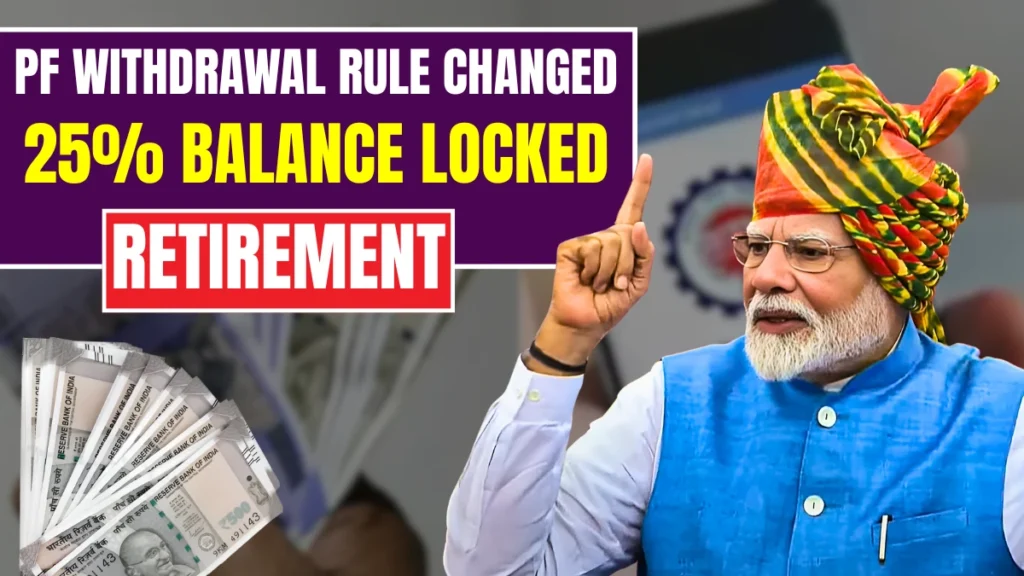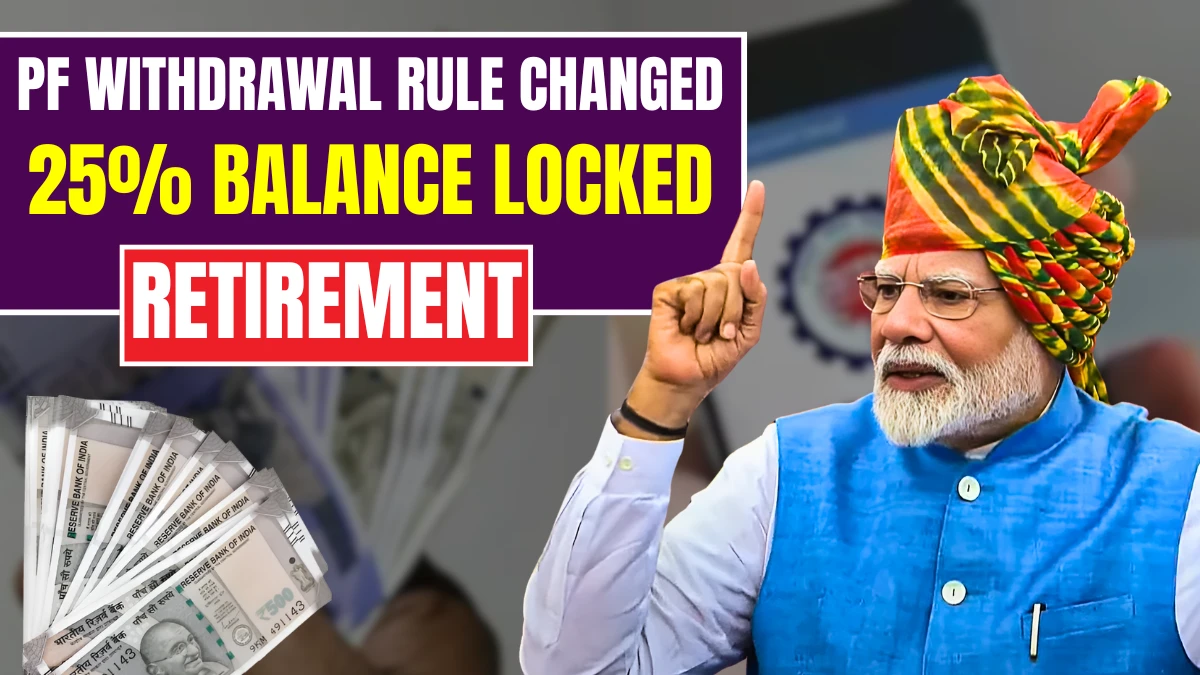The Employees’ Provident Fund Organisation (EPFO) has introduced new rules that significantly change how employees can access their PF savings. These changes are designed to promote long-term financial security but may also impact short-term liquidity for many workers.
Under the revised guidelines, only 75% of the PF balance can be withdrawn immediately, while 25% will remain locked until retirement. Additionally, a mandatory 12-month waiting period has been introduced for full withdrawal after exiting employment.

What The Rule Means
The new rule essentially divides your PF savings into two parts. When you leave a job or become unemployed, you can withdraw up to 75% of your PF balance. The remaining 25% will be held by EPFO until you reach the retirement age of 58. This locked portion is intended to ensure that employees have some financial support during their retirement years. The rule applies to all EPF account holders and is effective immediately.
Twelve Month Wait Period
Another major change is the introduction of a 12-month waiting period for full PF withdrawal. Previously, employees could withdraw their entire PF balance after two months of unemployment. Now, even if you are unemployed or have resigned, you must wait for a full year before you can access the eligible 75% portion. This rule is expected to reduce premature withdrawals and encourage long-term saving habits among workers.
Why The Rule Changed
The government’s rationale behind this change is to strengthen retirement planning and reduce dependency on social welfare schemes. Many employees tend to withdraw their PF savings early, leaving little to no funds for retirement. By locking a portion of the savings and introducing a waiting period, the EPFO aims to ensure that workers have a financial cushion when they retire. It’s a move toward building a more secure future for India’s workforce.
Impact On Employees
For employees, especially younger ones who frequently change jobs or take career breaks, this rule could be restrictive. Many rely on PF withdrawals during transitions or emergencies. With 25% of their savings locked and a year-long wait for the rest, financial planning becomes more complex. It may also discourage early withdrawals and promote disciplined saving, which aligns with the government’s long-term vision.
Planning For Emergencies
Given the new restrictions, employees must now rethink their emergency fund strategies. PF can no longer be considered a readily available source of cash during job transitions or financial crises. Workers should consider building separate emergency funds through savings accounts, fixed deposits, or other liquid instruments. Diversifying savings beyond PF will be crucial to maintaining financial flexibility.
Retirement Savings Protected
From a retirement perspective, the new rule offers a layer of protection. By ensuring that 25% of the PF balance remains untouched until retirement, employees are guaranteed a minimum corpus when they stop working. This could reduce the financial burden on families and the government, especially as life expectancy increases and healthcare costs rise. It’s a step toward creating a more self-reliant retirement system.
Role Of Employers Now
Employers will need to play a more active role in educating their workforce about these changes. HR departments should update onboarding materials, exit procedures, and financial wellness programs to reflect the new rules. Clear communication will be key to helping employees understand the implications and make informed decisions. Employers may also consider offering alternative savings plans to complement PF contributions.
Legal Framework Behind Rule
The EPFO has the authority to implement such changes under the Employees’ Provident Funds and Miscellaneous Provisions Act, 1952. The new rules are part of a broader policy shift aimed at improving financial literacy and retirement readiness. While some critics argue that it limits individual control over personal savings, supporters believe it’s a necessary step to ensure long-term financial stability.
Public Reaction Mixed
The public response to the new rule has been mixed. Some employees feel blindsided, especially those who were planning to withdraw their PF soon. Others see it as a positive move that will help them build a more secure future. Financial experts have urged workers to stay informed and adjust their savings behavior accordingly. The key is to understand the rule and plan ahead.
What You Should Do
If you’re an EPF account holder, now is the time to reassess your financial strategy. Don’t rely solely on PF for short-term needs. Explore other savings instruments like Public Provident Fund (PPF), National Pension Scheme (NPS), mutual funds, or recurring deposits. Keep track of your PF contributions and understand the withdrawal rules thoroughly. Consider consulting a financial advisor to create a balanced savings plan that meets both short-term and long-term goals.
Long Term Benefits Ahead
While the new rule may seem restrictive at first, it could offer substantial long-term benefits. By locking a portion of your savings and delaying full access, the EPFO is encouraging disciplined financial behavior. This could lead to better retirement outcomes and reduced financial stress in old age. Employees who embrace this change and plan accordingly will be better positioned to enjoy a secure and comfortable retirement.
Final Thoughts On Rule
The updated PF withdrawal rule is a clear signal that the government wants to promote responsible saving and reduce premature withdrawals. While it may cause short-term inconvenience, the long-term benefits are undeniable. Employees should take this opportunity to revisit their financial goals, diversify their savings, and make informed decisions about their future. With proper planning, this rule can become a stepping stone toward financial independence and retirement security.
Disclaimer
This blog post is intended for informational purposes only and does not constitute financial, legal, or professional advice. Readers are encouraged to consult with certified financial advisors or legal experts before making any decisions related to their PF accounts. The rules and interpretations may vary based on individual circumstances and official updates from EPFO. Always refer to the official EPFO website or contact your employer’s HR department for the most accurate and personalized guidance.
